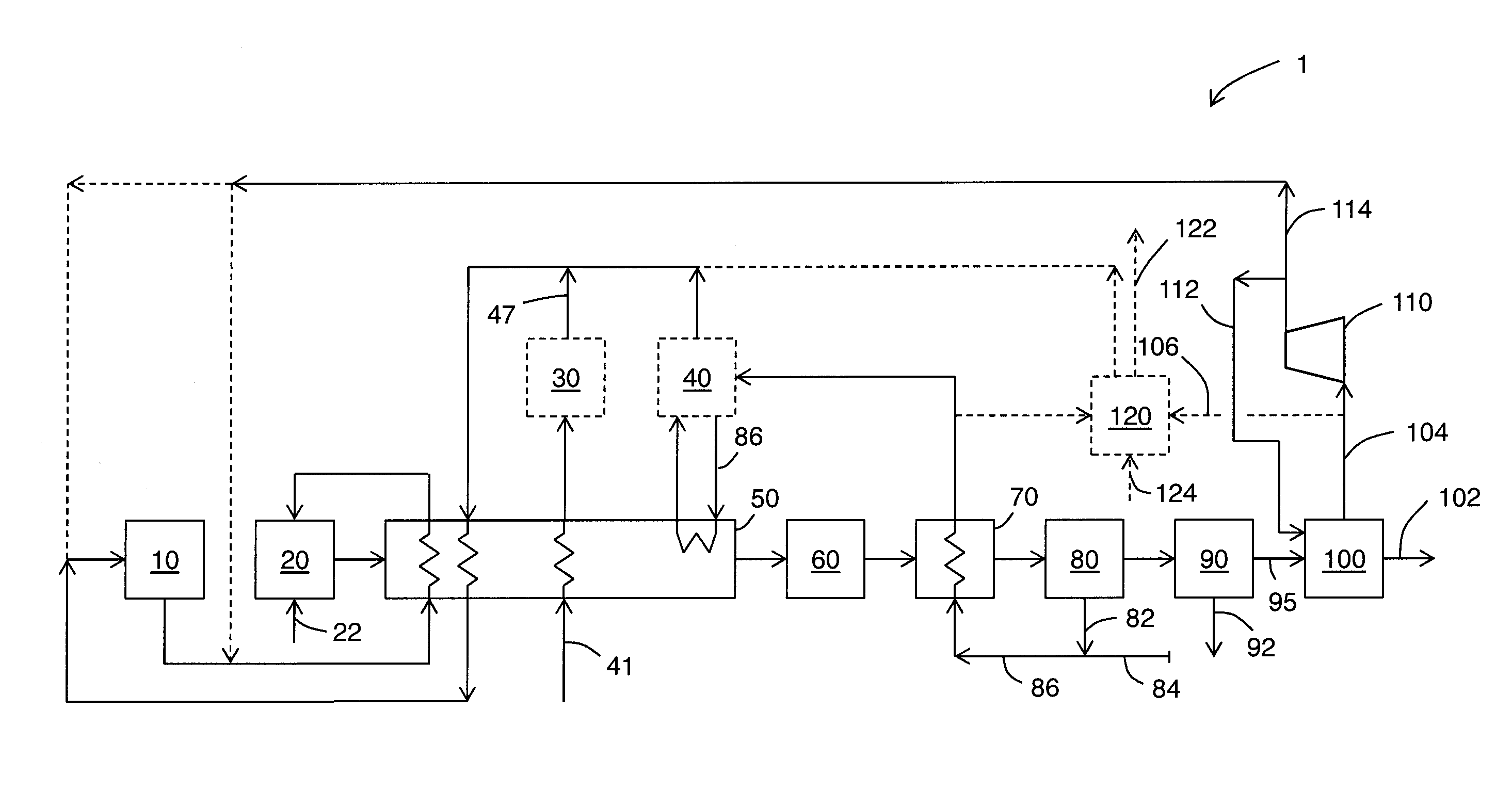Hydrogen Production Process with Low CO2 Emissions
a technology of co2 emissions and hydrogen production process, which is applied in the direction of hydrogen separation using solid contact, hydrogen separation using liquid contact, chemistry apparatus and processes, etc., can solve the problems of considerable loss of hsub>2 /sub>via the psa tail gas stream, and cannot achieve hydrogen product purity
- Summary
- Abstract
- Description
- Claims
- Application Information
AI Technical Summary
Benefits of technology
Problems solved by technology
Method used
Image
Examples
example 1
Comparative Example
[0168]The PSA cycle for example 1 is represented by FIG. 15a, but is not represented by FIG. 15b. For example 1, a portion of the PSA tail gas from PSA 210 is used as fuel 225, and a second portion 235 is compressed in compressor 220 and recycled to the hydrogen generator 200 as shown in FIG. 21. None of the PSA tail gas is recycled to the PSA adsorption system.
[0169]Stream compositions and flow rates for PSA feed stream 205 are summarized in Table 1. Stream compositions and flow rates for hydrogen product stream 215 are summarized in Table 2. Stream compositions and flow rates for fuel stream 225 are summarized in Table 3. Stream compositions and flow rates for PSA tail gas stream 235 recycled to hydrogen generator 200 are summarized in Table 4.
TABLE 1Flow RateComponentMole Fraction(kmoles / h)N20.0263154.7Ar0.00148.2CO20.003017.6CH40.007041.2CO0.0300176.4H20.93235482.3
TABLE 2Flow RateComponentMole Fraction(kmoles / h)N2 25 ppm0.1Ar677 ppm3.2CO200CH400CO00H20.9993477...
example 2
[0171]The PSA cycle for example 2 is represented by FIGS. 15a and 15b, where PSA tail gas is recycled to adsorption beds undergoing eq1d and eq2d, but not eq3d or eq4d. For example 2, a portion of the PSA tail gas from PSA 410 is used as fuel 425, a portion 435 is compressed in compressor 420 and recycled to the hydrogen generator 400 and another portion 445 is compressed and recycled to the PSA as shown in FIG. 22.
[0172]Stream compositions and flow rates for PSA feed stream 405 are summarized in Table 5. Stream compositions and flow rates for hydrogen product stream 415 are summarized in Table 6. Stream compositions and flow rates for fuel stream 425 are summarized in Table 7. Stream compositions and flow rates for PSA tail gas stream 435 recycled to hydrogen generator 400 are summarized in Table 8. Stream compositions and flow rates for PSA tail gas stream 445 recycled to the PSA system in beds undergoing eq1d and eq2d are summarized in Table 9.
TABLE 5Flow RateComponentMole Fracti...
example 3
[0174]The PSA cycle for example 3 is represented by FIGS. 16a and 16b, where PSA tail gas is recycled to adsorption beds undergoing eq1d and eq2d, but not eq3d or eq4d. For example 3, a portion of the PSA tail gas from PSA 410 is used as fuel 425, a portion 435 is compressed in compressor 420 and recycled to the hydrogen generator 400 and another portion 445 is compressed and recycled to the PSA as shown in FIG. 22.
[0175]Stream compositions and flow rates for PSA feed stream 405 are summarized in Table 10. Stream compositions and flow rates for hydrogen product stream 415 are summarized in Table 11. Stream compositions and flow rates for fuel stream 425 are summarized in Table 12. Stream compositions and flow rates for PSA tail gas stream 435 recycled to hydrogen generator 400 are summarized in Table 13. Stream compositions and flow rates for PSA tail gas stream 445 recycled to the PSA system in beds undergoing eq1d and eq2d are summarized in Table 14.
TABLE 10Flow RateComponentMole ...
PUM
 Login to View More
Login to View More Abstract
Description
Claims
Application Information
 Login to View More
Login to View More - R&D
- Intellectual Property
- Life Sciences
- Materials
- Tech Scout
- Unparalleled Data Quality
- Higher Quality Content
- 60% Fewer Hallucinations
Browse by: Latest US Patents, China's latest patents, Technical Efficacy Thesaurus, Application Domain, Technology Topic, Popular Technical Reports.
© 2025 PatSnap. All rights reserved.Legal|Privacy policy|Modern Slavery Act Transparency Statement|Sitemap|About US| Contact US: help@patsnap.com



